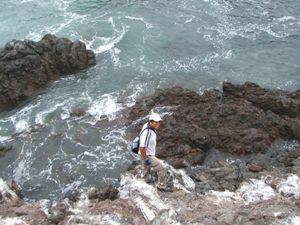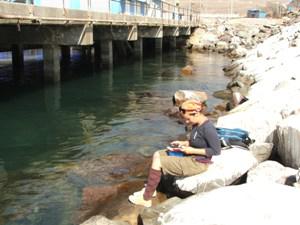Daniella Biffi Olivas
To estimate the population size of marine otters in two locations of Peru using non-invasive genetic sampling of their faeces and then use this information to create estimators that will allow researchers to monitor faecal abundance to determine marine otter abundance.

Marine otter in Tacna.
Marine otters are very difficult to observe and census. Currently, there is no reliable information about the population size of marine otters and there is no standard methodology for monitoring marine otter abundance. Behavioural studies of marine otters have concluded that they spend 80% of their time out of view (Medina-Vogel et al. 2006). In some locations, the only evidence of their presence is their faeces. Ideally, if researchers or trained assistants could simply monitor the abundance of faeces to determine otter abundance it would be possible to monitor this species on a regular basis. Genetic analyses of faeces have been used successfully to estimate the abundance of the Eurasian otter and river otter (Hung et al. 2004; Mowry et al. 2011). They identified individuals by genetically typing faeces and found that both the number of faeces at a latrine and the density of latrines were accurate predictors of otter abundance. Using the estimators developed by Mowry et al. (2011), researchers can now simply monitor faeces abundance without the need for the more expensive and labour intensive genetic analyses or observational censusing of river otters.

Field assistant in Tacna.
The goals of this project are to estimate the population size of marine otters in two locations in southern Peru using non-invasive genetic sampling of their faeces and then use this information to create estimators that will allow researchers to monitor faecal abundance to determine marine otter abundance. Determining the distribution and population trends of this species is critical information for the formulation of conservation strategies in Peru and elsewhere in South America. To achieve this goal, I will collect and map faecal samples at 17 sites in southern Peru and identify individual otters using microsatellite genetic markers. I will then estimate the number of otters at a site using these individual genotypes and determine whether this estimate of abundance is correlated with the number and abundance of faeces at a site. If these measures are strongly correlated as they are in river otters, it will be possible to simply count faeces and latrines at a site to estimate the number of marine otters for that site.

Collecting samples in the artisanal fishing port Puerto Grau.